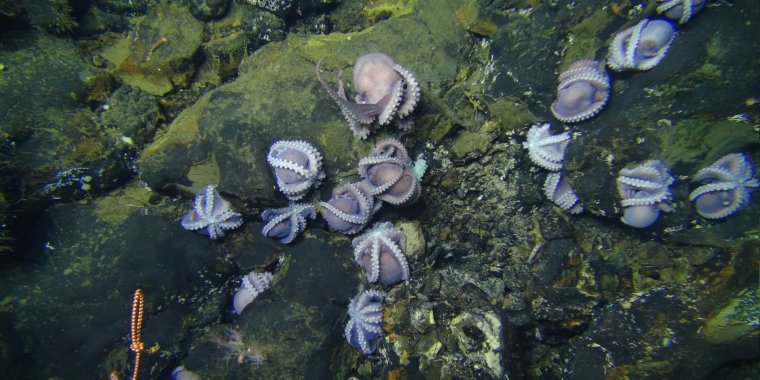| News / Science News |
Giant group of octopus moms discovered in the deep sea
We know more about the surface of the moon than we do about the bottom of the ocean. The seafloor is an alien landscape, with crushing pressures, near-total darkness and fluids wafting from cracks in the Earth's crust. It's also home to weird animals that scientists are only just getting to know.

Octopuses--17 of them--congregate on the deep-sea Dorado Outcrop; 16 are in brooding posture. Image credit: Phil Torres and Geoff Wheat
Nearly two miles deep in the Pacific Ocean and 100 miles off the coast of Costa Rica, scientists on two oceanographic cruises used subsea vehicles to explore the Dorado Outcrop, a rocky patch of seafloor formed of cooled and hardened lava from an underwater volcano.
Geochemists explored the outcrop in a submersible, hoping to collect samples of the warm fluids that emerge from cracks in the rocks. They didn't count on finding dozens of octopuses huddled around those openings.
The octopuses are an unknown species of the genus Muusoctopus -- pink, dinner-plate-sized creatures with enormous eyes. Up to 100 of them occupied every available rock in the area.
That in itself was strange -- Muusoctopus are normally loners. Stranger still was that nearly all the octopuses seemed to be mothers, each guarding a clutch of eggs. And this nursery was situated alongside the warm fluids issuing from the cracks in the outcrop.
Deep-sea octopuses usually live in cold waters. Exposure to higher temperatures jump-starts their metabolism, fueling a need for more oxygen than warm water can provide. So it doesn't make sense for deep-sea octopuses to brood eggs in warm water, scientists say: That's usually suicide.
Indeed, the octopuses the scientists observed showed evidence of severe stress. The researchers could only guess that the 186 eggs that were attached to the rocks faced the same challenges. None had any sign of a developing embryo.
Dorado Outcrop is not a great place to start an octopus family.
However, the sheer number of what the scientists think were doomed octopuses and their eggs suggests that there's a better habitat nearby.
The team suspects there must be more octopuses living inside crevices in rocks where the water is cool and rich in oxygen. These crevices could be such a good octopus environment that the booming population is forced to spill over into the dangerously warm region outside.
Janet Voight, a zoologist at the Field Museum in Chicago, told: "To my knowledge, there had been no reports of octopuses at this or comparable depths between Southern California and Peru. Never would I have anticipated such a dense cluster of these animals in the deep sea.
The numbers we see may simply be the surplus population. What else is down there we can't yet imagine?" (National Science Foundation)
YOU MAY ALSO LIKE





